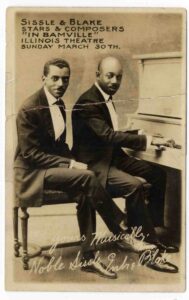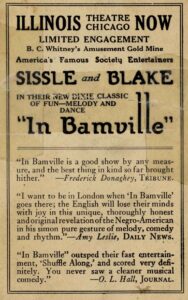YOUR DAILY DOSE OF EUBIE!!
To follow up on the success of Shuffle Along, Sissle and Blake hoped to create a more “sophisticated” show that would feature even less of the comic stereotypes that had been a feature of their previous hit. The show began its life titled In Bamville, and opened in Rochester, New York, in early March 1924. Later in March, the company moved to Detroit and then on to Pittsburgh, where Sissle was interviewed backstage by a reporter from the Pittsburgh Courier. Sissle commented on what the duo had learned from Shuffle Along’s success on the road: “We learned what the white audience wants, and why. We learned that the whites without question will accept colored artists and production of merit. They do not demand that we be buffoons and clowns, either. Of course, there must be comedy for an audience comes to a musical comedy primarily to laugh, but the more art we can work into the different scenes and situations, the better the show takes with the public. … And we portray Negro characters—not try to give an imitation of whites. Our love scenes are not as romantic as the whites, but they have the same universal touch and are applauded and appreciated.”
It’s interesting that Sissle still was sensitive to the question of the portrayal of black romance on stage; for many, the idea of romantic attraction that went beyond the mere sexual among blacks was unimaginable.
From the earliest planning of the new show, Sissle aimed to create a more “sophisticated” production—not only in terms of production values, but also in contents. He clearly wanted to set their work apart from the “lower” comedy of Miller and Lyles. One of the chorus numbers featured the girls in hoop skirts and broad hats, in the kind of glamourous display associated with white revues like the Ziegfeld Follies. Blake thought this was going too far, telling producer B. C. Whitney, “That scene is too beautiful for a colored show,” to which Whitney responded, “Eubie this is a not a colored show. This is Sissle and Blake’s show for Broadway.” According to Blake, the white audience always gasped when they say this number, shocked by the idea of fashionable black women. While emulating white musical comedies, Sissle still emphasized the unique “colored” flavor of the plot, music, and dancing. Trying to straddle the fine line between “colored” and “white” musicals would prove to be the key challenge and ultimate undoing of the duo’s new work.

The show’s next stop in April was Chicago, where Shuffle Along had previously played to capacity crowds. The Chicago Daily News critic noted that the new production opened just after D. W. Griffith’s Birth of a Nation was shown at the same theater, comparing the two disparate pictures of black life:
“In Bamville” … arrived at the Illinois [Theater]…close upon the heels of Griffith’s noble picture, “The Birth of a Nation,” suspected and maligned by the same race so proudly acclaiming the Sissle and Blake products. Nothing could have been more effective in pointing out a good reason for objecting to [Griffith’s portrayal of] their own nation… than the advantage of following the frowned-upon work of film art … Because not only was the Illinois stage blossoming with splendid talent entirely of the race who were slaves when the nation was in the throes of birth, but the delightful music and book, written by colored men, were both illuminative of their race and delivered by the colored actors in a way no white people could hope feebly to imitate…
The critic praised the production created by “100 percent black-and-tan American[s] and that means much to this country just after the glorious service the same race gave us in the big war.” Nonetheless, while acknowledging its inherent quality, the critic underscored that the players did not try to encroach on white theatrical styles:
They keep the comedy their own kind of comedy, they tune the jazz and balladry their own way and they dance…as only those whom we call Afro-Americans…There’s a lot of “Africa’s sunny clime” in Sissle’s music and a lot of the orient in their dances but it is American. And nobody on earth can dance exactly as they do no matter what great white dancers try to imitate our blacks.
Even worse than describing the cast as “our blacks,” this critic also noted that most of the players were not truly dark skinned, instead they were “mostly mulattos or octoroons fairer than they need be … and were black only when made up with burnt court.” While blacks viewed fair skin as a desirable trait, clearly whites were more comfortable with darker skinned actors keeping to stereotypical roles on stage.
While the Daily News critic compared In Bamville to Birth of a Nation, O. L. Hall writing in the Chicago Journal referenced Eugene O’Neill’s latest controversial play: “While Eugene O’Neill employs the title of an old spiritual to aver in his new and much debated multi-part drama that ‘all God’s chillum got wings.’ The authors of ‘In Bamville’ do not discuss matters of the soul, but their show decisively proves that all God’s chillum got dancin’ feet…While O’Neill, his brow furrowed with world-shaking thought, writes of miscegenation, these chanting, crooning, caroling, humming negroes just throw back their heads and let their hearts sing.

Clearly, the questioning of laws against racial admixture that O’Neill portrayed made this critic uncomfortable, who preferred “humming negroes” who didn’t push against social norms. The critic assures us that In Bamville is a show that won’t offend delicate white sensibilities: “You never saw a cleaner musical comedy in all your born days. There is never the slightest offense of speech or action; there always is a great outpouring of negro humor and melody.”
When directly asked whether they approved of O’Neill’s production, Sissle (speaking for the duo) typically took a conservative position, not questioning the artistry of the work but uncomfortable with confronting prejudice head on: “Personally, we would prefer not to have any play on the stage that may tend to stir up racial prejudice, which we are endeavoring to avoid. There’s too much prejudice as it is…Live and let live is our motto. But prejudice exists—that fact can not be doubted and we have reason to know. So why add fuel to the flames?”
Despite the mixed reviews, In Bamville had a solid run in Chicago, continuing through April.